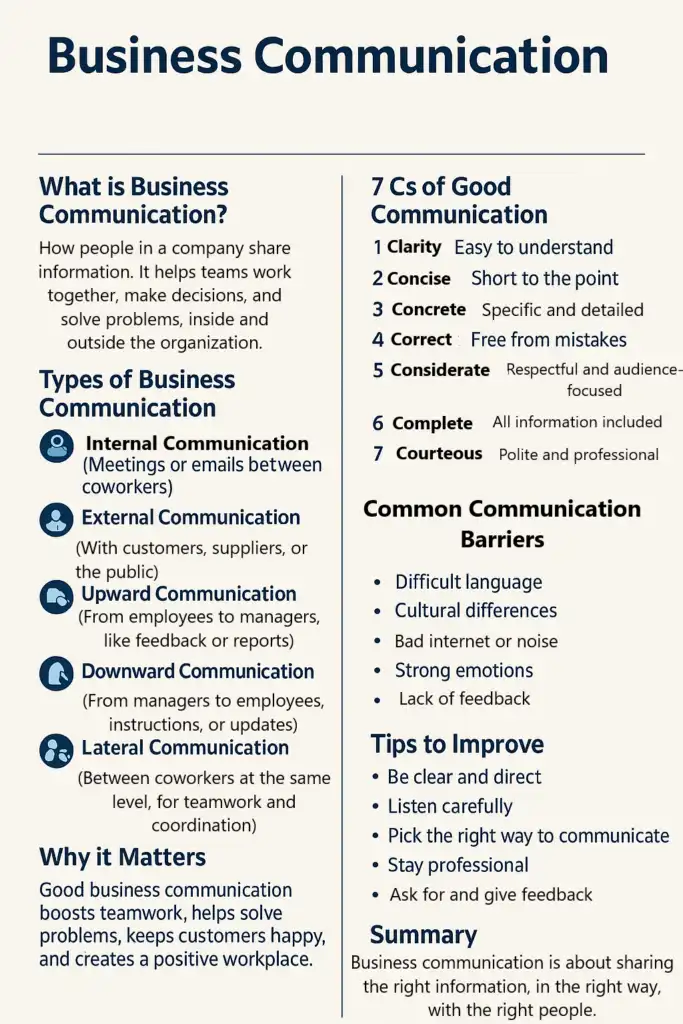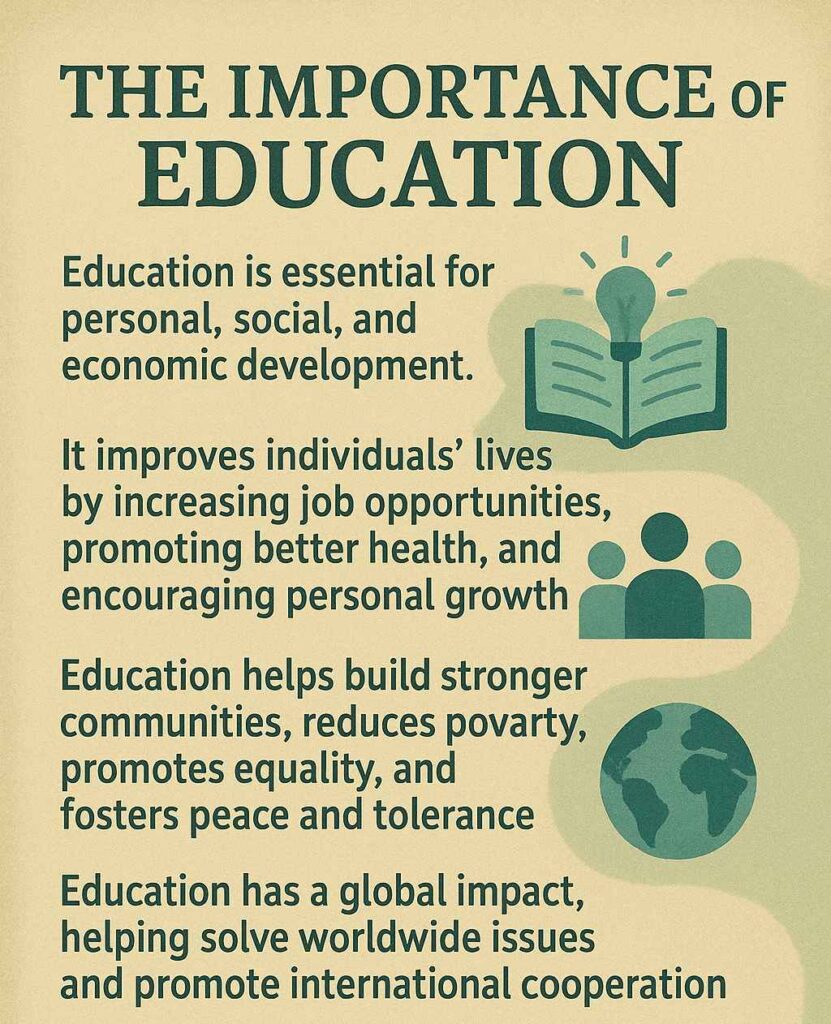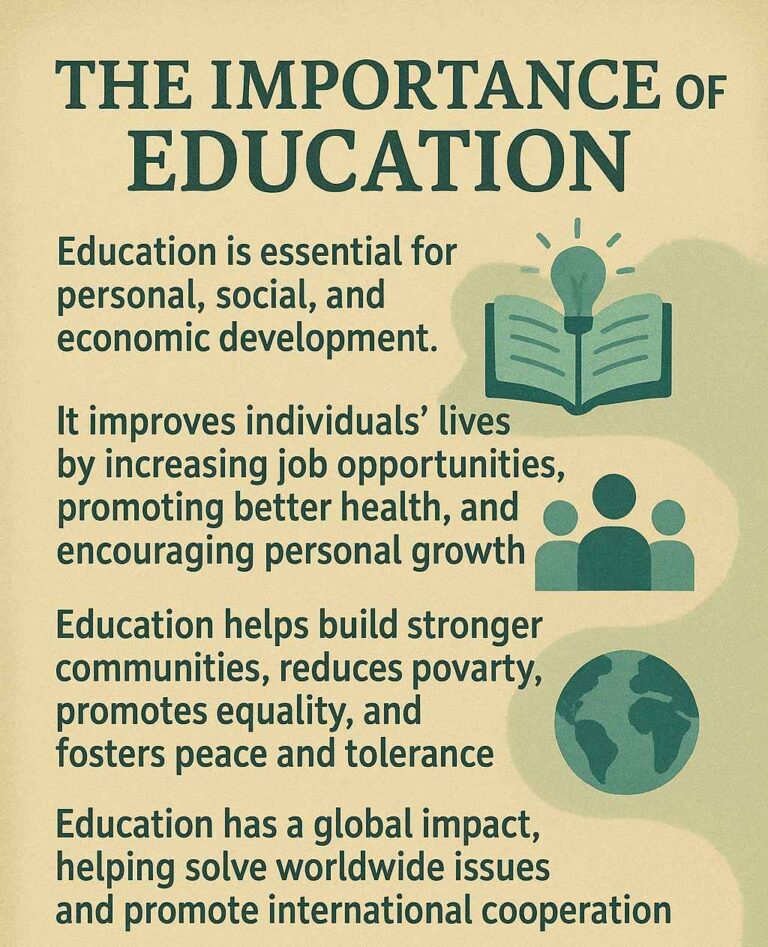Business Communication: An Easy-to-Understand Guide
Introduction: Business communication is the exchange of information, ideas, and messages within an organization or between organizations. It plays a crucial role in helping businesses run efficiently, make decisions, and build relationships with clients, employees, and stakeholders. Whether through emails, meetings, reports, or presentations, effective business communication ensures that everyone is on the same page and helps the business achieve its goals.

1. What is Business Communication?
Business communication involves the sharing of information related to business activities. It can be formal or informal, and it happens through various channels, such as face-to-face conversations, written documents, phone calls, emails, and virtual meetings. The goal is to convey messages clearly, promote understanding, and drive action.
Key purposes of business communication include:
- Informing: Providing necessary details to employees, customers, and stakeholders.
- Persuading: Encouraging people to take action or make decisions, such as convincing a client to buy a product.
- Building relationships: Fostering cooperation and trust between employees, clients, and business partners.
2. Types of Business Communication
Business communication can be categorized into several types, depending on the purpose and the people involved:
a. Internal Communication
This type of communication happens within the organization. It includes communication between employees, teams, and departments.
- Formal Communication: Official messages like emails, reports, or memos.
- Informal Communication: Casual chats, meetings, or quick conversations between colleagues.
b. External Communication
This type of communication happens between the organization and outside parties, such as clients, customers, suppliers, investors, and the public.
- Emails: Sending information to clients, partners, or customers.
- Press Releases: Publicly sharing news or updates about the company.
- Marketing and Advertising: Communicating the value of products or services to potential customers.
c. Upward Communication
This type of communication flows from employees to higher management. It includes feedback, suggestions, and progress reports.
- Example: Employees sharing their concerns with their manager or submitting reports.
d. Downward Communication
This communication flows from management to employees. It involves instructions, feedback, and policies.
- Example: A manager sending instructions for a project or sharing company updates with the team.
e. Lateral (Horizontal) Communication
This type of communication occurs between peers or colleagues at the same level in an organization. It helps in coordination and collaboration.
- Example: Team members discussing a project or sharing resources.
3. Channels of Business Communication
There are several ways to communicate in business, and choosing the right channel depends on the message’s importance, urgency, and audience.
a. Verbal Communication
Verbal communication is any form of communication that involves spoken words.
- Face-to-Face Communication: This is the most effective form because it allows for immediate feedback and non-verbal cues.
- Meetings and Conferences: These can be formal or informal, where teams discuss ideas, solve problems, or make decisions.
- Phone Calls and Video Calls: These are convenient for real-time conversations when face-to-face communication isn’t possible.
b. Non-Verbal Communication
Non-verbal communication involves body language, gestures, eye contact, and tone of voice. It is crucial in making interactions more engaging and ensuring the message is received as intended.
- Facial Expressions: Smiles, frowns, or raised eyebrows can add meaning to words.
- Gestures: Hand movements or nodding can show agreement or emphasize a point.
- Posture and Eye Contact: Positive body language helps in building trust and showing attentiveness.
c. Written Communication
Written communication is a formal and often permanent way of sharing information.
- Emails: Common for business communication, emails are quick and easy to send and receive.
- Reports and Proposals: These are detailed documents that convey important data, research, or recommendations.
- Memos: Short, official notes sent within the organization.
- Instant Messaging: Tools like Slack or Microsoft Teams provide quick written communication between employees.
d. Digital Communication
With the rise of technology, digital communication tools are increasingly popular in businesses.
- Social Media: Businesses use platforms like LinkedIn, Facebook, and Twitter to communicate with customers and build brand awareness.
- Company Websites: Often the first point of contact for potential clients.
- Video Conferencing Tools: Applications like Zoom and Microsoft Teams allow teams to meet and collaborate from different locations.
4. The 7 Cs of Effective Business Communication
To ensure communication is clear and effective, the 7 Cs are often used as guidelines. These are:
- Clarity: Be clear about the message you want to convey. Avoid using jargon or complicated language.
- Conciseness: Keep the message brief and to the point. Don’t include unnecessary information.
- Concreteness: Use specific facts and figures instead of vague terms.
- Correctness: Ensure your message is grammatically correct and free of errors.
- Consideration: Think about the audience’s perspective and tailor the message to their needs.
- Completeness: Include all necessary information so the recipient has what they need to understand or act on the message.
- Courtesy: Be polite and respectful in your communication.
5. Barriers to Effective Business Communication
Several barriers can hinder effective communication in business:
a. Language Barriers
Using complex language or industry jargon that not everyone understands can make communication difficult.
b. Cultural Barriers
In global businesses, differences in culture, traditions, and customs can lead to misunderstandings.
c. Physical Barriers
These include technical issues like poor internet connections, background noise, or unclear audio during virtual meetings.
d. Emotional Barriers
Strong emotions such as anger, stress, or frustration can affect how a message is delivered or received.
e. Lack of Feedback
Without proper feedback, it can be hard to know whether a message has been understood correctly.
6. Importance of Business Communication
Effective communication is essential for the smooth operation of any organization. Here are a few reasons why business communication is so important:
- Decision Making: Clear communication helps managers make informed decisions.
- Productivity: Good communication helps teams collaborate and stay organized, which increases productivity.
- Conflict Resolution: Open lines of communication can help resolve misunderstandings and conflicts before they escalate.
- Customer Satisfaction: Businesses that communicate effectively with customers build stronger relationships and ensure customer needs are met.
- Team Morale: Employees who feel informed and included are more likely to be motivated and engaged.
7. Tips for Improving Business Communication
To communicate more effectively in a business environment, consider the following tips:
- Be Clear and Direct: Avoid ambiguity and ensure that the message is simple and easy to understand.
- Listen Actively: Pay attention to what others are saying without interrupting. Respond thoughtfully to show understanding.
- Choose the Right Medium: Decide whether to communicate via email, phone, or face-to-face based on the situation’s urgency and importance.
- Be Professional: Always maintain a respectful and professional tone, especially in written communications.
- Encourage Feedback: Create a culture where feedback is welcomed and acted upon to improve future communication.
Conclusion:
Business communication is the foundation of successful businesses. It ensures that information flows smoothly within an organization and to external stakeholders. By mastering the different types of communication, understanding key communication principles, and overcoming common barriers, businesses can enhance productivity, build strong relationships, and create a positive work environment. Effective communication is not just about sharing information; it’s about ensuring that the right message gets to the right people in the right way at the right time.
Summary:
Business communication is the process of exchanging information within and outside of an organization. It includes various types of communication such as internal, external, upward, downward, and lateral communication, each serving different purposes. Effective communication relies on clear, concise, and correct messaging, along with the proper choice of communication channels, such as verbal, non-verbal, written, and digital communication. Overcoming barriers like language differences and emotional reactions is crucial for successful communication. By fostering strong communication practices, businesses can improve productivity, resolve conflicts, and build strong relationships with both employees and customers.








